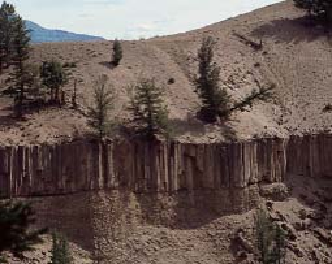Travel Reference
In-Depth Information
Basalt columns in an ancient lava flow are overlain by younger sediments in The Narrows of Yel-
lowstone Canyon.
Another example of basalt lava columns is at Sheepeater Cliffs, but the columns at Ob-
sidian Cliff and Mount Jackson formed in rhyolite lava.
—B.J.G/J.S.
2.2/16.1 Devil's Den
(with very little parking along the road) is a collection of fantastic
rock formations just above Tower Fall and extending up Tower Creek's canyon. When F. V.
Hayden named this feature, he was probably thinking of a thicket called the Devil's Den on
the battlefield at Gettysburg, a battle fought only eight years before.
Devil's Hoof,
with an obvious cleft, stands tall and alone in the Devil's Den jumble. The
rock in these formations is not formed by columnar jointing. The Devil's Den rocks were de-
posited by streams or mudflows as horizontal layers of volcanic debris. Vertical cracks formed
in the beds of debris, the rain and the river eroded material from the cracks, and pillars re-
mained. Such formations are called hoodoos. Similar hoodoos in even more bizarre shapes
occur on the approach road to the East Entrance.
2.4/15.9
Tower Creek bridge. Tower Creek has been found to be the coldest stream in the
park, with a typical summer temperature of 45°F (7°C).
2.5/15.8
One-way road to the west to
Tower Fall Campground
and picnic
area large Tower Fall parking lot to the east. This campground has 32 nonreservable sites, pit
toilets, and an amphitheater for evening ranger programs.



